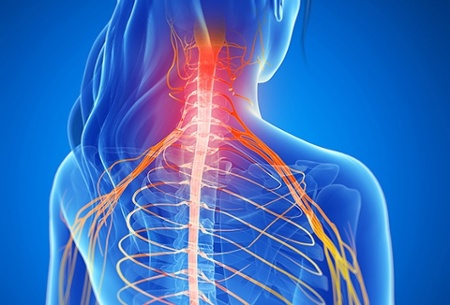
Causes of Neck Pain and Treatment Options

Causes of Neck Pain and Treatment Options
Neck pain is a common complaint across the country, and is particularly prevalent among those who work in sedentary conditions. Most of the time, neck pain is temporary and is not a cause for alarm. However, when pain continues for an extended period of time, or you find yourself unable to find relief, it is prudent seek the services of a pain management professional. This is especially the case if numbness or loss of strength in the arms or hands, or shooting pain in the shoulder or down the arm occur. Living with pain can not only negatively impact quality of life, but can also exacerbate the condition through feedback loops in the nervous system.

Causes
Neck pain can be acute or chronic, mild to severe, and widespread or isolated. It may result from a number of causes that span the interconnected neurological, musculoskeletal, and vascular systems. Pain neurotransmitters may be released when nerves are stimulated by trauma or pressure, when muscles are strained, when joints are pressured or damaged, or when the surrounding tissues are inflamed. Stress, as in many conditions, can contribute to and exacerbate neck pain.
- Muscle strain: Leaning toward the computer screen or hunching over a work desk for a prolonged period of time, poor posture, reading in bed, and even gritting one’s teeth may result in muscle strain that can cause neck pain.
- Aging and Osteoarthritis: Like with other joints in the body, neck joints wear down with age and the cartilage between our vertebrae deteriorates. This forms bone spurs that affect joint motion and can result in reduced mobility, pain, and stiffness.
- Neck hernia or compression of nerves: A neck hernia is a bulge in an intervertebral cervical disc that presses on the nerves that run down the neck and back. When nerves are compressed, pain, numbness, and more serious consequences may result. It is common for pain resulting from a hernia to radiate down the shoulders and arms.
- Traumatic Injuries: Automobile, boat, horse riding, or other accidents in which the head is jerked backward or forward, can place strain the soft tissues, muscles, and joints of the neck resulting in whiplash trauma and the associated pain.
- Diseases such as rheumatoid arthritis, meningitis, and fibromyalgia.
Prevention
Maintaining an overall healthy lifestyle helps to reduce the risks for many medical conditions, including neck pain. A healthy diet and abstinence from smoking can help to reduce risks that contribute to neck pain. A sensible exercise regime can help to strengthen the muscles that support the neck in daily life, but also in cases of traumatic accidents. Resting and caring the neck when experiencing limited mobility, stiffness, or pain can help to prevent further injury. Finally, the maintenance of good posture when standing, walking, sitting, and lying down is paramount. Adjust the height of your chair or monitor to reduce the likelihood of straining when using the computer, take frequent breaks when working at a desk to stand and stretch, and ensure that your head and neck are adequately supported when in bed.

Treatment Options
Treatment begins with a thorough diagnosis by a specialist, using a number of diagnostic tools. Because neck pain can have a multitude of causes, it is important to rule out any underlying trauma or disease. If there are signs of trauma, then the patient is instructed on how to care for the neck while the body repairs. Inflammation may be treated with oral or injectable anti-inflammatory medication, muscle spasms can be treated with oral medication or botox injections, and nerve pain can be treated with joint blocks and other procedures. A number of treatment options exist, and a pain specialist ought to create an individualized treatment plan for the patient.
- Over the counter and prescription medication
- Epidural injections
- Nerve/ joint blocks
- Injections at trigger points
- Massage therapy
- Evaluation for surgical repair
- Physical therapy
- Acupuncture
- Pain medicine
- Neurostimulation therapy
- Botox Injections
If you suffer from neck pain and want to know more about treatment options, contact New York Neurology today. If you would like to schedule an appointment or check for availability, please click "Book Online" below or call (646) 679-6609.
See Also:
- Neck Pain
- Back Pain
- Headaches
- Nerve Pain
- Epidural Injections
- Joint Blocks
- Trigger Point Injections
- Botox Injections
You Might Also Enjoy...


A third of eligible migraine patients were not offered preventive therapy

Neurological Symptoms in Covid-19 "Long-Haulers"

New NYNA Tourette Syndrome Study

Seizures: Understanding and Overview


